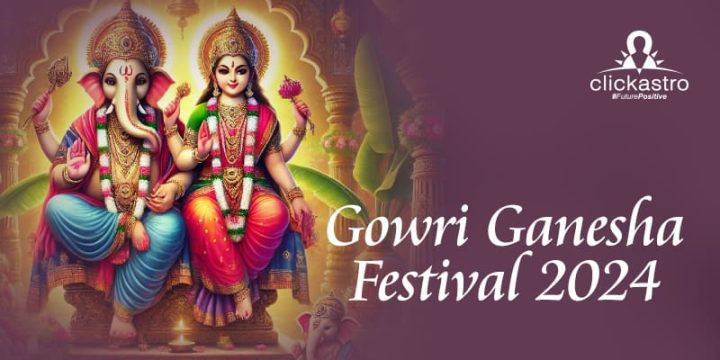The Gowri Ganesha festival is celebrated with great zeal and enthusiasm and holds a special place in the hearts of millions of Hindus across the world. Known by various names such as Gowri Habba, Gowri Pooja, or Hartalika Teej, this festival brings families and communities together to worship Goddess Gowri and her son, Lord Ganesha.
In 2024, the Gowri Ganesha festival falls on September 6, Friday.
The Gowri Ganesha festival is dedicated to Goddess Gowri. It is celebrated on the third tithi of the Bhadrapada month in the
Hindu calendar (usually in August or September). Goddess Gowri is believed to visit her parents’ home on this day, and women observe the Swarna Gowri Vratha to seek her blessings, especially for a happy and prosperous married life.
The festival sees the installation of meticulously crafted idols or images of Goddess Gowri. Elaborate pooja rituals take place in homes, marked by the chanting of sacred mantras, and offering of flowers, fruits, and traditional dishes to the goddess. In regions like Tamil Nadu, Karnataka, and Andhra Pradesh, the festival is known as Gauri Habba. In Maharashtra and other North Indian states, this festival is observed as Hartalika Teej.
Women fast, visit temples and participate in colorful processions, demonstrating their devotion to Goddess Parvati (Gowri) and seeking her blessings for a prosperous married life. The Gowri Ganesha festival is a celebration of the divine bond between a mother and her son, symbolizing the importance of family ties and love. It also emphasizes unity and cultural diversity as people from various regions celebrate the festival with their unique customs.
Read about Mangala Gauri Vrat
Gowri Ganesha festival 2024 Date And Puja Time
For the celebration of Gauri Habba and Gowri festival the auspicious day and time for the puja this year is:
- Gowri Ganesha festival – Friday, 6th September 2024
- Pratahkal Gowri Puja Muhurat/Timings – 5:24 AM to 7:52 AM
- Duration – 2 Hours 28 Mins
- Tritiya Tithi Starts – 12:20 PM on 05 September 2024
- Tritiya Tithi Ends – 03:00 PM on 06 September 2024
Gowri Ganesha – Honoring Goddess Gowri
The Gowri Ganesha festival pays homage to Goddess Gowri, the loving mother of Lord Ganesha. This festival holds deep spiritual significance and is celebrated with great devotion, particularly by married women who seek blessings for a harmonious married life and unmarried girls hoping for suitable life partners. The festival also serves as a conduit for seeking peace, prosperity, and the fulfillment of desires.
The Symbolic Turmeric Idols:
Central to the Gowri Ganesha festival are the symbolic idols of Goddess Gowri, traditionally crafted from turmeric. These idols are referred to as “jalagauri” or “Arishinadagauri” idols. While many still make these idols at home, ready-made clay idols of the goddess are readily available in local markets, making them more accessible for devotees.
The Puja:
The puja itself is performed with meticulous precision. The goddess’s image is placed on a plate that typically contains a grain of rice or wheat. To conduct the puja, a high degree of “suchi” (cleanliness) and “shraddha” (dedication) is required.
Mandapa and Decoration:
Around the idol, a mandapa is set up, often adorned with banana stems and mango leaves, symbolizing auspiciousness. The idol of Gowri is adorned with cotton, a vastra (silk cloth or saree), and fragrant flower garlands. One of the key elements of the puja involves women having their ‘gowridaara’ (a sacred thread with 16 knots) tied to their right wrists as part of the vratha, symbolizing the strengthening of their marital bonds and seeking the goddess’s blessings.
The Bagina:
As an integral part of the vratha, at least five “baginas” are meticulously prepared. Each “bagina” is a collection of items, including a packet of arshina (turmeric), kumkuma (vermilion), black bangles, black beads (used in the mangalsutra), a comb, a small mirror, a piece of clothing, cereals, rice, lentils, wheat or rava, and cubes of chopped jaggery. These items symbolize different facets of a married woman’s life and her aspirations for her family’s well-being.
Mangala-Dravya and Prasadam:
In Karnataka and many parts of South India, families come together to celebrate this important occasion. Parents of married women often send gifts and money as a gesture of love and Mangala-Dravya. Delicious prasadam, including sweet dishes like payasa, obbattu, bajji, holige, and other delights, is dedicated to the deity and later enjoyed by friends and family.
The Continuation to Ganesh Chaturthi:
The Gowri Ganesha festival sets the stage for the grand celebration of
Ganesh Chaturthi. It is believed that Goddess Gowri arrives at her parent’s home on this occasion, and Lord Ganesha comes the following day to escort her back to Mount Kailash.
Gowri Ganesha Puja rituals
The Gowri Ganesha Puja is observed predominantly by married women, although unmarried girls also participate in seeking blessings for a suitable life partner. This puja is marked by a series of intricate and meaningful rituals that culminate in the worship of Goddess Gowri and, subsequently, Lord Ganesha.
1. The Purifying Morning Bath:
The day of the puja begins with an auspicious ritual – a holy bath. Women rise early in the morning and cleanse themselves as an act of spiritual purification. This bath signifies physical and mental purity, preparing them for the sacred rituals ahead.
2. Attire and Adornment:
After the bath, women adorn themselves in elegant sarees and jewelry. This attire symbolizes not just external beauty but also inner purity and grace. The choice of clothing is often significant, reflecting the vibrant colors of the festivities.
3. Setting Up the Goddess’s Idol:
One of the central elements of the Gowri Ganesha Puja is the installation of a statue or image of Goddess Gowri. Skilled artisans often create these idols, and they are placed in a designated area within the home, typically on a clean and decorated platform.
4. Offerings to Goddess Gowri:
Devotees lovingly offer a variety of items to Goddess Gowri. These offerings include fragrant flowers, shringaar (cosmetics and adornments), vermillion (sindoor), and delicious sweets. Each item is symbolic, representing the love and devotion of the worshipper.
5. Chanting Aarti and Reciting Katha:
With the idol beautifully adorned, devotees chant Aarti, which is a hymn or prayer dedicated to the deity. It’s a moment of deep spiritual connection as they seek blessings and protection. Additionally, the recitation of the Katha (narrative or story) associated with the puja holds great significance, narrating the divine tale of Goddess Gowri.
6. Offering Bhog Prasad:
The next step involves presenting Bhog Prasad, which is a special offering of food to Goddess Parvati (Gowri). This prasad often consists of traditional dishes and sweets that are considered her favorite. This offering symbolizes the devotee’s love and devotion, as well as their gratitude for the goddess’s blessings.
7. Breaking the Fast:
After a day filled with devotion and fasting, the puja concludes with women breaking their fast in the evening. This moment is eagerly awaited, and it’s customary for devotees to consume fruits and milk products. Breaking the fast together with family and friends adds a sense of joy and camaraderie to the occasion.
Significance and Essence of Gowri Ganesh Festival
The Gowri Ganesh festival holds profound significance in Hindu culture. This festival is not only a time of worship but also a celebration of family bonds, spirituality, and the pursuit of blessings.
1. Blessings for Married Women:
Gowri Ganesh festival is primarily dedicated to Goddess Gowri, and it holds special importance for married women. They observe fasting and perform the puja to seek the blessings of the goddess for a happy and harmonious married life. This ritual underscores the profound bond between a husband and wife, emphasizing the importance of unity and love in marital relationships.
2. Seeking Ideal Life Partners:
Unmarried girls also participate in this festival, fasting with the hope of finding an ideal life partner. The festival carries the belief that their devotion will lead them to a suitable spouse, emphasizing the significance of love and partnership in life.
3. Setting the Tone for Ganesh Festival:
Gowri Ganesh festival acts as a prelude to the Ganesh festival. It sets a joyous and spiritual tone for the days that follow, marking the arrival of Lord Ganesha. The transition from worshipping Goddess Gowri to Lord Ganesha symbolizes the importance of family traditions and the seamless flow of spiritual devotion within a household.
4. Spiritual and Health Benefits:
Beyond the personal and family-centric aspects, Gowri Ganesh puja is believed to have various other benefits. It is said to help prevent blood-related diseases and diminish the negative effects on the planet, underlining the festival’s ecological and holistic significance. Additionally, it is associated with overcoming obstacles, winning legal battles, and achieving financial stability, indicating its role in promoting well-being and prosperity.
5. Mitigating Doshas and Fostering Peace:
The festival is also believed to have astrological benefits, such as reducing the manglik dosha in girls. Furthermore, the worship of Goddess Gowri is said to bestow peace of mind and enhance the spiritual and material aspects of life. It is a time for inner reflection and growth, fostering a sense of peace and contentment.
6. Unity and Togetherness:
One of the most beautiful aspects of the Gowri Ganesh festival is how it brings families and communities together. It’s a time for collective worship, sharing, and celebrations. The rituals performed with loved ones strengthen bonds and create lasting memories.
Conclusion:
As we approach the Gowri Ganesha festival of 2024, there’s a palpable sense of anticipation and enthusiasm in the air. This celebration is not just a religious observance; it’s a profound cultural and spiritual experience that resonates deeply with millions of devotees.
The festival is dedicated to Goddess Gowri, the epitome of motherhood and marital bliss. It’s a time when married women fast and pray, seeking her divine blessings for a life filled with harmony and love. Unmarried girls join in, hoping to find their ideal life partners, underlining the festival’s universality in embracing the dreams and aspirations of all its participants.
The transition from Gowri Ganesh to Ganesh Chaturthi, when Lord Ganesha arrives to escort Goddess Gowri back to Mount Kailash, exemplifies the continuity of traditions within families. It symbolizes the enduring spirit of togetherness and the seamless flow of devotion from one deity to another.
At its core, the Gowri Ganesha festival is a celebration of faith, love, and tradition. It is a vivid tapestry woven from the threads of devotion, familial bonds, and cultural heritage. The rituals performed are not mere actions but profound expressions of gratitude, seeking blessings for happiness, prosperity, and well-being.
As the rituals unfold, they serve as a poignant reminder of the rich cultural tapestry of India, where diverse traditions coexist harmoniously. It is a time when communities come together, strengthening the bonds of unity and togetherness.
Whether you actively participate in the festivities or simply observe from afar, the Gowri Ganesha festival promises an unforgettable experience. It invites everyone to partake in the essence of faith, love, and tradition, transcending barriers and embracing the shared values that make festivals like this a cherished and timeless part of our cultural heritage. Ultimately, it is a celebration that reaffirms the enduring beauty of devotion and the warmth of familial ties that make our lives richer and more meaningful.









